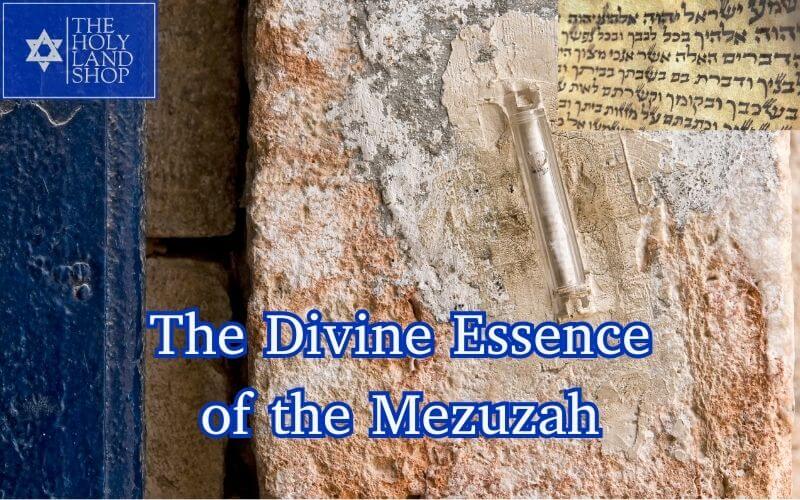A Mezuzah is a profound symbol in Judaism. It comprises a parchment enclosed in a decorative case. Scripted on the parchment are Hebrew verses from the Torah. Specifically, these verses are from Deuteronomy. The Mezuzah is traditionally affixed to the doorposts of Jewish homes. Entryways within the home often have one, too.
The significance of the Mezuzah is multi-layered. Firstly, it acts as a constant reminder of God’s presence and commandments. When passing through a doorway, it encourages mindfulness of one’s faith. Secondly, it symbolizes the sanctity of a Jewish home. Consequently, it transforms a house into a place intertwined with spirituality and divine guidelines.
Moreover, the Mezuzah serves a protective role. It is often regarded as a guardian of the Jewish household. As such, it fosters a sense of security and divine watchfulness. Thus embedding spiritual ambiance into the mundane aspects of daily life. In doing so, it ensures that faith isn’t just limited to synagogues or times of prayer. Instead, it becomes integrated into routine life, enveloping one’s existence with sanctity and divine presence.
In conclusion, the Mezuzah isn’t merely a ritual object. It embodies a convergence of tradition, faith, and daily existence. It is a small yet potent emblem of Jewish identity and divine connection. Through it, the thresholds of Jewish homes echo with the essence of faith and tradition. Each passage through a doorway becomes a moment of divine remembrance and reflection.

Historical Origins of the Mezuzah
The roots of the Mezuzah trace back to biblical times. Initially, its inception is found in the Torah, particularly in Deuteronomy. Here, commandments stipulate its placement on the doorposts of Jewish homes. Historically, this practice aimed at keeping the commandments in daily consciousness.
Over time, the Mezuzah underwent various evolutions. These changes reflected shifts in interpretation, design, and societal norms. For instance, the decorative cases which house the parchments became more elaborate. The materials, designs, and artistic embellishments diversified, mirroring changing tastes and influences.
Additionally, the significance attributed to the Mezuzah expanded. Besides being a reminder of the commandments, it evolved into a symbol of protection. In this role, it came to be seen as a guardian against negative forces. Consequently, the Mezuzah’s presence became synonymous with divine watchfulness over the household.
The Mezuzah also stood as a mark of Jewish identity in various historical periods. Its conspicuous placement served to affirm one’s faith and heritage openly. Furthermore, it subtly underscored the intertwining of divine guidelines with everyday life.
In conclusion, the Mezuzah’s journey is rich with historical and spiritual evolution. Its transformation from a biblical commandment to a multifaceted symbol illustrates its enduring relevance. Thus, it remains a potent emblem, intertwining the past, present, and divine in Jewish tradition and homes.
The Physical Components and Artistry of the Mezuzah
At the heart of the Mezuzah lies the scroll, or Klaf. Inscribed on it are specific Torah verses, meticulously written by a skilled scribe. This process is intricate, adhering strictly to time-honored traditions. The Klaf embodies the essence of the Mezuzah, holding deep spiritual significance.
Transitioning to its exterior, a variety of cases enclose the Klaf. Materials range from simple woods and metals to elegant glass and stone. Each case reflects the aesthetic preferences and religious devotion of the homeowner. Every material and design carries its symbolism, adding layers of meaning.
Artistry doesn’t just stop at materials. Designs are often symbolic, embodying various aspects of faith and tradition. For instance, some Mezuzah cases feature the Hebrew letter ‘Shin.’ This letter represents one of God’s names, showcasing divine connection.
Moreover, Mezuzah cases might also showcase images of Jerusalem, animals, or other biblical themes. These visual elements narrate stories, celebrate heritage, and express personal or spiritual sentiments. Consequently, each Mezuzah becomes a unique piece of art, enhancing the doorway it adorns.
In conclusion, the Mezuzah’s components are more than physical elements. They are a canvas portraying faith, tradition, and personal expression. Through a blend of scripture and artistry, each Mezuzah tells its captivating tale.
The Spiritual Significance of the Mezuzah
The Mezuzah is a powerful symbol steeped in profound spiritual significance. Central to this is the Shema prayer. Inscribed within, the Shema is a declaration of faith, a cornerstone of Jewish belief. It is a daily reminder of God’s oneness and the commandment to love God wholeheartedly.
Next, let’s explore its protective aspect. Many believe the Mezuzah guards the home and its inhabitants. This belief transforms every entrance into a sanctified space, imparting a sense of divine oversight and care. Thus, the Mezuzah operates as both a spiritual emblem and a physical safeguard.
Additionally, the Mezuzah embodies the continuity of faith. Each time it is noticed upon entering or leaving a room, a silent acknowledgment of God’s commandments occurs. In doing so, it fosters a constant connection with divine teachings, nurturing the spiritual life of the home and those within.
In conclusion, the Mezuzah is not merely an object. It is a vessel of spirituality, weaving the divine into the fabric of daily life. The Mezuzah serves as an unwavering beacon of faith through the Shema prayer and its symbolic protection.
Proper Placement and Installation
Initiating the installation of a Mezuzah involves understanding essential guidelines and customs. Primarily, it’s affixed at the entrance of Jewish homes. Specific rooms within the house also commonly receive a Mezuzah. However, there are exemptions, such as bathrooms and closets, where placement is avoided due to the sanctity of the Mezuzah.
The positioning on the doorpost follows a meticulous approach. Generally, it’s placed on the right side of the door as one enters the room. There’s also a specific height at which it’s installed, usually about shoulder-high. An angle inward towards the room is another traditional aspect of its placement, at least for Ashkenazi Jews.
Variations do exist within these practices. Different Jewish communities may have nuanced traditions, whether Ashkenazi, Sephardi, or others. However, these distinctions align with the central goal of fulfilling the divine commandment.
Remember, the installation isn’t just a physical act. It’s also a spiritual dedication, typically accompanied by a blessing. This blessing emphasizes the commandment’s sanctity and the Mezuzah’s significance in connecting the home to divine presence and protection.
In conclusion, installing a Mezuzah is a thoughtful process, blending tradition, law, and spirituality. It represents a meaningful observance, symbolizing the home’s sanctity and the inhabitant’s adherence to their faith.
The Mezuzah in Contemporary Judaism
The Mezuzah is pivotal in contemporary Judaism, bridging ancient traditions with modern practices. Its presence graces the doorposts of Jewish homes and institutions, signifying faith and divine protection. For many, it is a continuous reminder of their heritage, subtly infusing spirituality into daily life.
Modern stories and anecdotes underscore the Mezuzah’s enduring relevance. For instance, some families have tales of finding solace and guidance in the words encased within the Mezuzah during challenging times. These personal accounts often depict the Mezuzah as a source of comfort and a beacon guiding the way forward.
Community stories also highlight the communal role of the Mezuzah. In neighborhoods, its universal design symbolizes shared beliefs and values, fostering a sense of unity and belonging. Additionally, the Mezuzah often plays a part in various life milestones, appearing in ceremonies like housewarmings or other celebratory gatherings.
Despite the shifts in society and the evolution of practices, the Mezuzah remains steadfast in its significance. Its essence, a blend of tradition and adaptability, resonates deeply within Jewish lives. In essence, the Mezuzah in contemporary Judaism exemplifies a vibrant tradition, echoing historical richness while embracing the rhythms of modern life.
Purchasing a Mezuzah
Various considerations ensure you acquire an authentic and meaningful piece when purchasing a Mezuzah. Initially, focus on the scroll inside, called the “Klaf.” An authentic Klaf contains handwritten verses from the Torah, penned by a skilled scribe, a Sofer.
Next, consider the case housing the scroll. Many designs and materials are available, ranging from simplistic to ornate. Your choice should reflect personal taste and honor the sanctity of the Mezuzah’s contents.
In addition to aesthetics, consider the Mezuzah’s durability. Since many choose to place the Mezuzah outdoors, opting for weather-resistant materials like metal or glass is wise. These materials ensure that the Mezuzah maintains its integrity over time.
It’s also crucial to research the seller’s credibility. Purchasing from reputable Judaica stores or online platforms specializing in Jewish religious items guarantees a higher likelihood of obtaining an authentic product.
Consider also the size of the Mezuzah. Ensure it fits the intended space while remaining easily noticeable and accessible for touching or kissing upon passing by.
Lastly, seek a Mezuzah that resonates with you. The Mezuzah, rich in significance, should be a reflection of your faith and spiritual aspirations. Its selection, therefore, deserves time and thoughtful consideration, ensuring it becomes a cherished addition to your living space. Thus, a carefully chosen Mezuzah becomes an object of religious obligation and a meaningful symbol of Jewish identity and faith.
Conclusion
The Mezuzah plays a pivotal role in preserving Jewish tradition and identity. It is a constant reminder of the covenant between God and the Jewish people, reinforcing a sense of belonging and historical continuity. Every placement on a doorway symbolizes a steadfast adherence to faith, subtly weaving divine consciousness into the fabric of daily existence.
Embracing the Mezuzah’s spiritual essence enriches life, transforming doorposts into conduits of blessing and protection. It invites introspection and spiritual alignment, guiding one’s journey through the thresholds of life with purpose and divine intent.
In conclusion, the Mezuzah is not merely an object affixed to doorways. It embodies a living tradition, whispering tales of perseverance, faith, and divine connection. It encourages the infusion of spirituality into mundane routines, turning each entry and exit into a moment of reflection and sanctity. Thus, it is an enduring symbol, inviting every Jewish soul to walk paths laden with tradition, spirituality, and divine presence.
Bottom Line
The Mezuzah is a powerful symbol of tradition and faith, an artifact that reverberates with spiritual significance. Its presence transforms spaces, imparting divine protection and wisdom. If you feel called to enrich your space with the profound essence of the Mezuzah, don’t hesitate. Connect with us and embark on a journey of spiritual discovery and divine connection. Embrace the tradition, safeguard your thresholds, and let the Mezuzah be a guide and guardian in your spaces and life.
Get in touch today, and allow us to assist you in finding a Mezuzah that resonates with your spirit and home.
